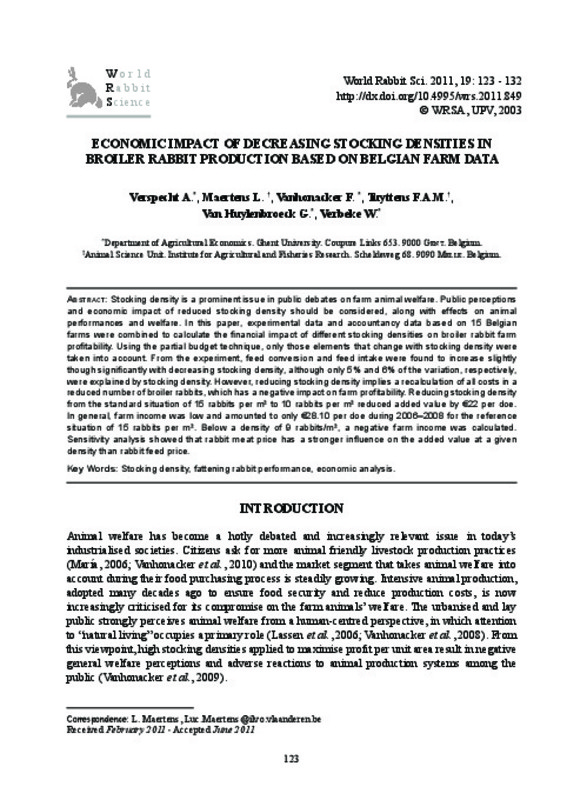JavaScript is disabled for your browser. Some features of this site may not work without it.
Buscar en RiuNet
Listar
Mi cuenta
Estadísticas
Ayuda RiuNet
Admin. UPV
Economic impact of decreasing stocking densities in broiler rabbit production based on Belgian farm data
Mostrar el registro sencillo del ítem
Ficheros en el ítem
| dc.contributor.author | Verspecht, Ann
|
es_ES |
| dc.contributor.author | Maertens, Luc
|
es_ES |
| dc.contributor.author | Vanhonacker, F.
|
es_ES |
| dc.contributor.author | Tuyttens, Frank
|
es_ES |
| dc.contributor.author | Van Huylenbroeck, Guido
|
es_ES |
| dc.contributor.author | Verbeke, Wim
|
|
| dc.date.accessioned | 2011-10-19T12:50:24Z | |
| dc.date.issued | 2011 | |
| dc.identifier.issn | 1257-5011 | |
| dc.identifier.uri | http://hdl.handle.net/10251/12210 | |
| dc.description.abstract | [EN] Stocking density is a prominent issue in public debates on farm animal welfare. Public perceptions and economic impact of reduced stocking density should be considered, along with effects on animal performances and welfare. In this paper, experimental data and accountancy data based on 15 Belgian farms were combined to calculate the financial impact of different stocking densities on broiler rabbit farm profitability. Using the partial budget technique, only those elements that change with stocking density were taken into account. From the experiment, feed conversion and feed intake were found to increase slightly though significantly with decreasing stocking density, although only 5% and 6% of the variation, respectively, were explained by stocking density. However, reducing stocking density implies a recalculation of all costs in a reduced number of broiler rabbits, which has a negative impact on farm profitability. Reducing stocking density from the standard situation of 15 rabbits per m² to 10 rabbits per m² reduced added value by 22 euros per doe. In general, farm income was low and amounted to only 28.10 euros per doe during 2006-2008 for the reference situation of 15 rabbits per m². Below a density of 9 rabbits/m², a negative farm income was calculated. Sensitivity analysis showed that rabbit meat price has a stronger influence on the added value at a given density than rabbit feed price. | es_ES |
| dc.description.sponsorship | This research is funded by the Agency for Innovation by Science and Technology in Flanders (IWT Vlaanderen), Brussels, Belgium. We gratefully acknowledge the Flemish Association of Poultry and Rabbit Breeders, and especially Ilka Hertogs for their willingness to provide the used accountancy data. | |
| dc.description.tableofcontents | 132 | |
| dc.language | Inglés | es_ES |
| dc.publisher | Editorial Universitat Politècnica de València | es_ES |
| dc.relation.ispartof | World Rabbit Science | |
| dc.rights | Reserva de todos los derechos | es_ES |
| dc.subject | Stocking density | es_ES |
| dc.subject | Fattening rabbit performance | es_ES |
| dc.subject | Economic analysis | es_ES |
| dc.title | Economic impact of decreasing stocking densities in broiler rabbit production based on Belgian farm data | es_ES |
| dc.type | Artículo | es_ES |
| dc.date.updated | 2011-10-18T13:13:12Z | |
| dc.identifier.doi | 10.4995/wrs.2011.849 | |
| dc.rights.accessRights | Abierto | es_ES |
| dc.description.bibliographicCitation | Verspecht, A.; Maertens, L.; Vanhonacker, F.; Tuyttens, F.; Van Huylenbroeck, G.; Verbeke, W. (2011). Economic impact of decreasing stocking densities in broiler rabbit production based on Belgian farm data. World Rabbit Science. 19(3). https://doi.org/10.4995/wrs.2011.849 | es_ES |
| dc.description.accrualMethod | SWORD | es_ES |
| dc.relation.publisherversion | http://doi.org/10.4995/wrs.2011.849 | |
| dc.description.upvformatpinicio | 123 | |
| dc.description.volume | 19 | |
| dc.description.issue | 3 | |
| dc.identifier.eissn | 1989-8886 | |
| dc.identifier.eissn | 1989-8886 | es_ES |
| dc.contributor.funder | Agency for Innovation by Science and Technology, Flanders |








